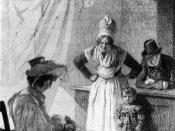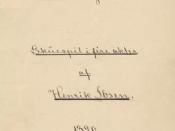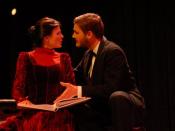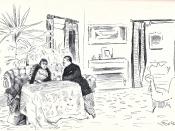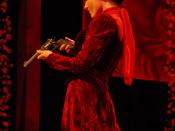The physical words and underlying meanings of "enclosures" and "enclosed spaces" can mean much more than their actual meaning when reading works of literature. The realistic authors, Flaubert, Tolstoy, and Ibsen all present the idea of "enclosures" and "enclosed spaces" literally and metaphorically in their writings, Madame Bovary, The Death of Ivan Ilych, and Hedda Gabler. They do this through situations, they display it within their characters, and also through using the literal meaning of the phrases.
In Madame Bovary, Emma lived a life of enclosure and control. She always felt and seemed trapped within her life. Emma's life was very routine and that in itself leaves one to feel enclosed. Flaubert gives us an example of this when he states, "she always accompanied him to the foot of the steps outside the door. If his horse hadn't been brought around she would wait there with him. At such moments they had already said good-bye, and stood there in silence."
(pg. 1098). This is an example presented to us that lets us see into her life and how it is more like a job to her. Her life was surrounded by lies and she felt so enclosed by them she could not separate them from reality. Through all the lies that are being told throughout the story, it makes it impossible for them to seem and feel more like reality, rather than merely lies. Flaubert describes, "That by lying the lovers make it impossible for words ever to touch at the truth in things." Flaubert, as a realistic writer, believes romance and love are more accurately displayed through realism. He uses ironic romantic descriptions to establish a connection between his characters. Flaubert focused a great deal of this work on women and their lack of power during that day and age. An example of this is how Emma prayed that her child would be a boy because she knows the pain, sorrows and feelings of entrapment that come with being a woman during this time. Men had a certain power over women that allowed them to control women. This was a power that most women did not even possess themselves, the power to make a difference in their life. Flaubert mostly describes this power to the reader through displaying it in the relationships Emma had with the men in her life. All the women in this novel and the women that lived in this time felt trapped and limited to these "enclosed spaces" in which then could live their life. They did not feel they had the power or ability to step outside of those limits put there by men and society.
In Hedda Gabler, the entire play is literally taking place in an "enclosed space." The play is shown completely in the Tesman's living room and one small room next to it. I also find the characters in this play to be enclosed and driven by fear. Many of the characters fear a great deal of things, it is almost what the play is about. Tesman has a small fear for his Aunt Juliana because she raised him and still continues to support him financially. Tesman also fears the return of his old academic rival, Eilert Loevborg. This fear makes him feel trapped, enclosed and inferior to his former rival. However, Loevborg encounters some "enclosed spaces" when he finds himself in jail after a night of drinking. After getting out of prison, Eilert finds that his manuscript is gone and with the assistance of Hedda giving him her pistol he enters a completely enclosed place, death. The shocking news of his missing manuscript drives him to the point of committing suicide. Ibsen does a great job of using the literal meaning and also the metaphorical meaning of "enclosed spaces" throughout his play.
In the story of The Death of Ivan Ilych, Tolstoy compares inner life to outer life throughout the story. He also shows how ones spiritual life can interfere with ones outer life. (sparknotes.com) Therefore, we start off by seeing two separate enclosed spaces, your inner life and your outer life. Tolstoy displays through Ivan what happens when you intertwine your spiritual life and physically life with one another. He says because Ivan denies his spiritual he is unable to enjoy and benefit from his physical. Ivan becomes trapped in this in-between of his physical and spiritual life. He is unable to find a way to combine the two and truly live a fulfilled life. Tolstoy, at one point in the story allows his character to become more focused on his spiritual life which led to him seeing that the less important your physical life, the more important your spiritual life. Ivan spent most of the story enclosed between the two.
Each of these authors uses this idea of "enclosed spaces" extremely well, both literally and metaphorically. They are also not just able to do it within the characters, but within the stories itself. It also makes it easy to relate the three stories and compare them because they are all written during the realistic period and a time in history where many people did suffer from feeling trapped and enclosed in their life in some way. This was the reality of the time period and all of the authors used this concept to display it in works of literature.

